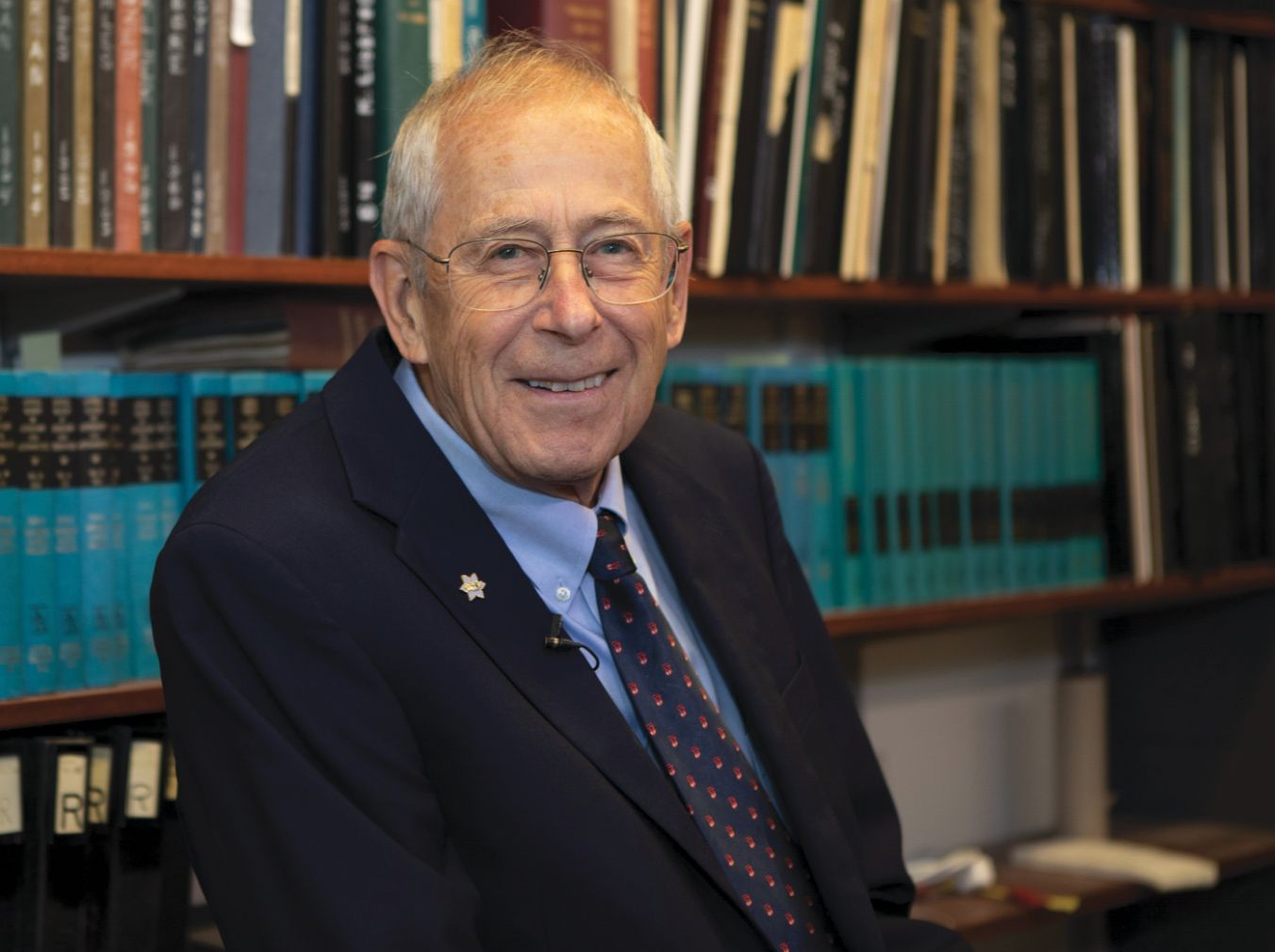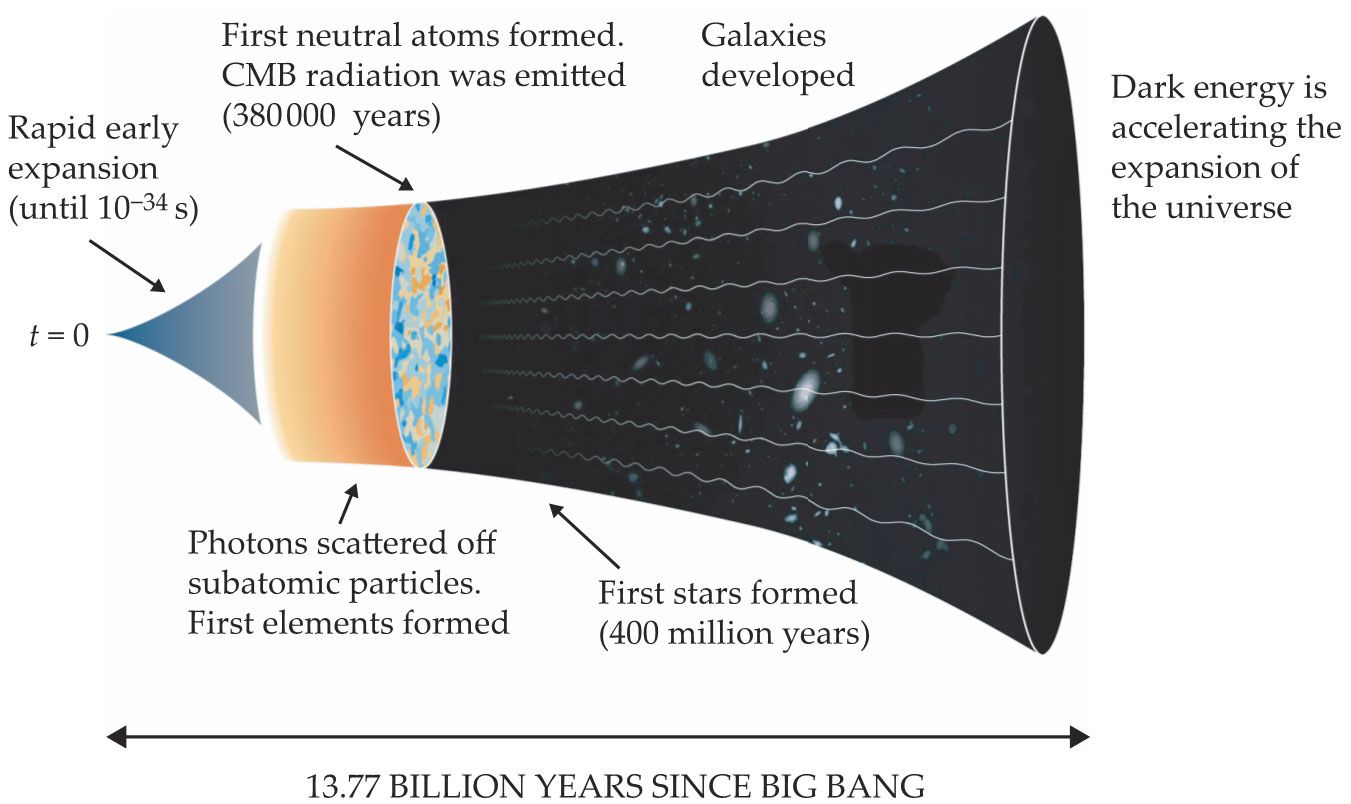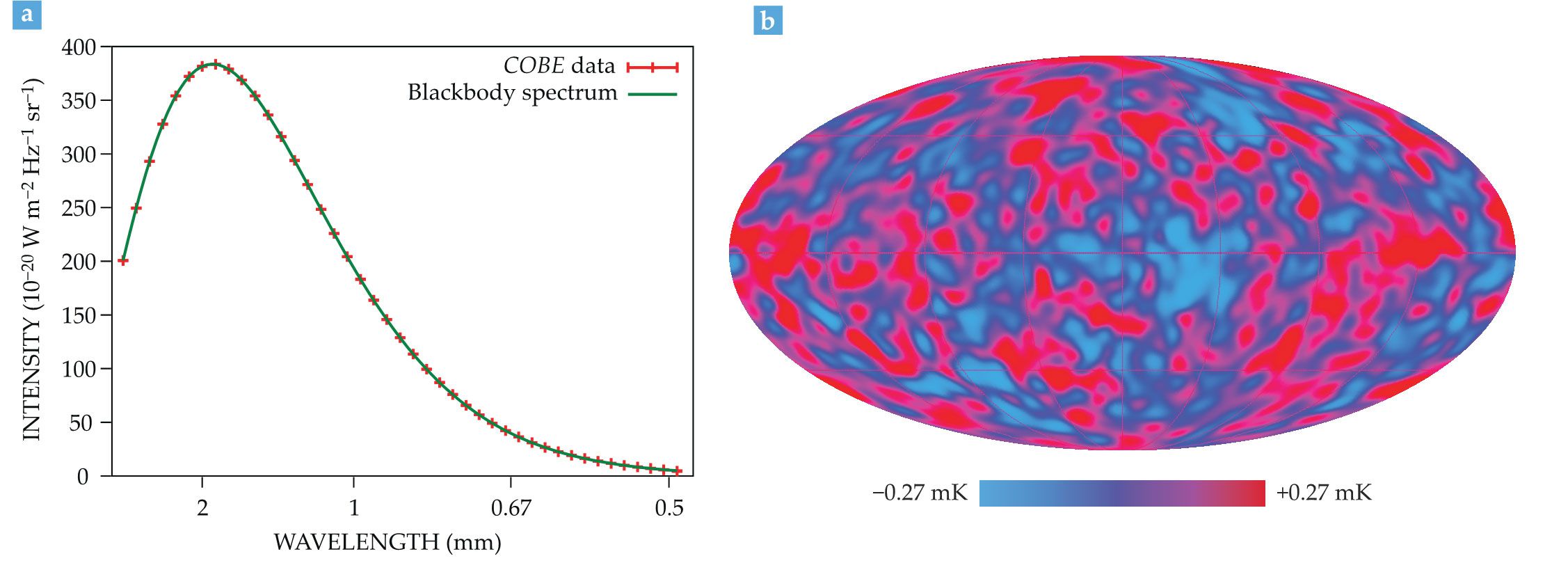Physical cosmology wins a share of the Nobel Prize in Physics
DOI: 10.1063/PT.3.4357
How and when did the universe begin? How has it evolved? What will be its fate? Albert Einstein and others pondered those questions in the early part of the century. But not until 1929, when Edwin Hubble observed that galaxies were moving away from ours in every direction, did solid empirical evidence begin to support any postulated answers. And not until the second half of the century did cosmology transition from a highly abstract discipline to a field in which accepted theories had to conform to measurements.
After World War II, cosmology discussions revolved around two competing theories. Relativistic evolution, which became known as Big Bang theory, postulated that the universe is expanding from an ultra-dense point that contained all the matter in today’s universe. The alternative steady-state theory rejected the concept of a moment of creation and postulated that although the universe is expanding, matter is continuously created so that the average density of the universe remains unchanged. (See the article by Geoffrey Burbidge, Fred Hoyle, and Jayant Narlikar, Physics Today, April 1999, page 38.
James Peebles, at Princeton University, changed that. Beginning in the 1960s, he laid out a framework of precise mathematical theories about the universe’s evolution that have continued to be verified by empirical observations. He posed questions that coupled mathematical analyses to potential physical consequences; for example, he asked what patterns of galaxies should be observable today based on different possible conditions in the earliest moments of the universe. This year, the Royal Swedish Academy of Sciences recognized Peebles with the Nobel Prize in Physics for his “theoretical discoveries in physical cosmology.”

James Peebles
PRINCETON UNIVERSITY, OFFICE OF COMMUNICATIONS, DENISE APPLEWHITE

Off the beaten path
Apart from Hubble’s, the lack of observations with which to test theories meant that cosmology had long been regarded as more of a speculative endeavor than a quantitative science. Only 30 to 40 cosmology papers per year appeared in the scientific literature in the 1950s. When Peebles moved from Manitoba to New Jersey to begin graduate studies at Princeton in 1958, most newly minted physics PhDs would never have had the opportunity to take a course that covered the then arcane theory of general relativity.
Princeton was the exception. John Wheeler brought general relativity to the physics department in 1954 and promoted academic discourse on how to model phenomena in our galaxy and beyond. (See the article by Charles Misner, Kip Thorne, and Wojciech Zurek, Physics Today, April 2009, page 40
By his own admission, Dicke was not then aware of work by Soviet American theorist George Gamow and colleagues that, in hindsight, defined contemporary cosmological theory. Gamow had argued in 1948 that a big-bang universe would at first be dominated by high-energy radiation. (See the Reference Frame by Michael Turner, Physics Today, December 2008, page 8
Pigeon droppings or CMB?
In 1964 Peebles prepared a manuscript that described how a dense “primeval fireball” of subatomic particles and radiation expanded and cooled to create the universe. As the universe cooled, the particles lost some of their energy, and atomic nuclei began to combine with electrons to form stable atoms. Radiation no longer scattered off the highly ionized matter and was free to travel unimpeded as the universe expanded to its current density.
Peebles also predicted the radiation would have a thermal, blackbody spectrum. He calculated that the radiation would have cooled from an initial temperature greater than 1010 K down to just 10 K. Concurrently, colleagues Wilkinson and Peter Roll developed a radiometer to measure radiation at a wavelength of 3 cm, chosen to rule out emissions from other extraterrestrial sources, which should be orders of magnitude cooler at that wavelength. The team intended to measure the temperature of radiation emitted by the early universe.
Arno Penzias and Robert Wilson of Bell Labs beat them to that measurement. Still riding the post-war radio astronomy wave, Bell Labs had built an antenna to detect radio signals as part of an early satellite communication system. When the antenna became obsolete, it was made available for research, giving Penzias and Wilson the chance to use it to examine radio signals originating from the space between galaxies. Instead, their 1964 measurements revealed a persistent hum of microwave noise at a temperature of 3.5 K, coming from every direction. The researchers considered possible sources for the noise including pigeon droppings that had collected in the antenna. When a colleague told them about Peebles’s work, a logical explanation for the persistent hum appeared. The thermal noise was a relic of the Big Bang in the form of blackbody radiation with a peak emission in the microwave region. “That measurement had a dramatic impact. It turned cosmology into a quantitative science,” says Kaiser. For their work, Penzias and Wilson were awarded the 1978 Nobel Prize (see Physics Today, December 1978, page 17
In 1965 Peebles, Dicke, and their colleagues published a paper in Astrophysical Journal that linked the cosmic microwave background (CMB) radiation measurement with Peebles’s calculations of a hot Big Bang afterglow. 1 That paper cemented the Big Bang as the prevailing cosmological model. It also stated that “more measurements are needed to determine a spectrum” to test that the CMB, at all wavelengths, matched a blackbody. Decades would pass before those measurements could be made.
Peebles went on to develop many of the concepts that underlie modern understanding of the universe’s evolution (see figure
Figure 1.

James Peebles laid out a framework for the evolution of the universe. Models and observations based on his work continue to refine the predictions about key stages of the universe’s past, some of which are shown here. (Nobel Prize organization.)

In 1966 Peebles calculated that helium-4 would have emerged as the dominant nuclide from the hot plasma of the seconds-to-minutes-old universe. Working backward from the universe’s present CMB temperature, mass density, and expansion rate, he determined that helium-4 would have made up 26–28% of the early universe’s matter. That value has been confirmed in numerous observations. In 1968, he proposed that free protons and electrons combined 380 000 years after the Big Bang to form neutral hydrogen atoms that, along with helium, make up most of the early universe’s matter. 3 Those and other calculations set the stage for understanding how matter is distributed on large scales throughout the universe.
The case for dark matter
Peebles sought to explain how different types of matter could have clustered and evolved into the uneven distribution that makes up the contemporary universe. Pressure waves oscillating in the hot plasma before neutral atoms began to form compressed some regions of plasma and stretched others, producing minute variations in density. Slightly denser regions in a near-uniform distribution of matter attracted more matter via gravitation, which led to clusters of gas and stars. In 1970 Peebles, with graduate student Jer Yu, determined that early density variations should correlate with observable CMB temperature fluctuations. 4 Over long time scales, those anisotropies would have magnified and created today’s distribution of galaxies. Similar calculations were carried out simultaneously in the Soviet Union by Yakov Zeldovich, but neither scientist knew about the other’s work.
To investigate galactic evolution, Peebles and Princeton astronomer Jeremiah Ostriker conducted numerical simulations that tracked the motion of stars orbiting in a disk like that of our own galaxy. For an object the size of the Milky Way the stars rapidly rearranged themselves into an elongated bar-shaped object—nothing like the spiral shape of the Milky Way and numerous other galaxies. “Lo and behold, if a galaxy looks like astronomers said it should, that galaxy should be wildly unstable,” says Ostriker.
To explain the apparent conflict, Peebles and Ostriker revived an idea presented by Fritz Zwicky in the 1930s. Zwicky had concluded that galaxies bound by gravity into a cluster must contain a large amount of “dark” matter that is not accounted for by the mass of stars in those galaxies. By adding a distribution of such dark matter to their simulations, Ostriker and Peebles found that a recognizable galactic structure emerged. 5 The extra dark matter existed as a spherical halo surrounding the main stellar disk and prevented it from turning into a bar. They estimated that the total mass density of dark matter in the universe was 0.2 of the “critical value” that would give the universe a flat geometry. That estimate is very close to today’s current best estimate of 0.26.
“In the 1970s, people began to think about dark matter as more than just a puzzle,” says Simon White, a director of the Max Planck Institute for Astrophysics. White and his colleague Martin Rees built on Peebles’s work to formalize a hierarchical process in which dark matter first clustered into halos due to gravitational forces. The ordinary matter in those halos then cooled and condensed to form the more easily observed dense luminous component of galaxies. (For more on galaxy formation, see Jeremiah Ostriker and Thorsten Naab, Physics Today, August 2012, page 43
Astronomical observations lent further support for Peebles’s predictions of dark matter. Vera Rubin, Kent Ford, and others measured the orbital speeds of stars and gases at different distances from the center of the Andromeda Galaxy. (See the Reference Frame by Vera Rubin, Physics Today, December 2006, page 8
The elusive lambda
David Spergel, theoretical astrophysicist at Princeton, says “Peebles and Ostriker showed that the stability of disk galaxies required the existence of dark matter.” But although nobody knew what it really was, Peebles hypothesized in 1982 that the universe was dominated by “massive, weakly interacting particles” that do not interact with radiation and that travel at nonrelativistic speeds—in other words, cold dark matter. 6 He calculated that in such a universe, the CMB would have a temperature variation of 5 parts in 100 000, a value, he explains, that illustrates “the important observation that the distribution of galaxies is very clumpy, while the distribution of radiation is close to smooth.”
At the time, “most people had glommed on to the idea that the Einstein–de Sitter model was the simplest model of the universe,” says Peebles. That model posits an expanding universe of critical mass density and zero curvature. But by 1984 Peebles was skeptical that the universe’s mass could be as large as the model suggested.
In his original theory of general relativity, Einstein had introduced a scaling parameter Λ, called the cosmological constant, to achieve a static universe. He later abandoned the idea because it contradicted observations of an expanding universe. (See the article by Tom Banks, Physics Today, March 2004, page 46
Things unknown
Measurement by NASA’s Cosmic Background Explorer (COBE), proposed in 1974 by Nobel laureates George Smoot and John Mather and launched in 1989, provided the measurements that showed that ΛCDM was on the right track. (See Physics Today, December 2006, page 18
Figure 2.

Thermal radiation from the early universe, as measured by NASA’s Cosmic Background Explorer (COBE). (a) The Far Infrared Absolute Spectrophotometer measured the cosmic microwave background (CMB) at wavelengths from 0.1 to 10 mm. The solid curve shows a blackbody spectrum, at a temperature of 2.725 K, as predicted by the Big Bang theory. (b) The Differential Microwave Radiometer measured fluctuations in the CMB radiation at a level of 1 part in 100 000. This sky map, created from the first two years of COBE data, provided the first view of the anisotropies in the CMB. Those variations gave rise to the structures seen today. (Courtesy of NASA’s Goddard Space Flight Center.)

ΛCDM is also consistent with the 1998 discovery that the universe’s expansion rate is accelerating (see Physics Today, June 1998, page 17
Peebles pins high expectations on explicit observations of dark matter, and he anticipates that measurements in the dark sector are a “Nobel Prize waiting.” The Wide-Field Infrared Survey Telescope, for example, slated to launch in the mid 2020s, will measure how the distribution of galaxies has changed over time and provide another measure of how dark energy and dark matter have affected the cosmos. “They’re looking for deviations from the simple picture. We give dark energy a label but it doesn’t act like a physical force. It’s just a number as far as we know,” says Ostriker. And understanding why some galaxies deviate from the ΛCDM model is, according to Peebles, a rich field for future work. “I don’t believe that a theory is ever final. We’re still fishing around for something,” he says.
References
1. R. H. Dicke, P. J. Peebles, P. G. Roll, D. T. Wilkinson, Astrophys. J. 142, 414 (1965). https://doi.org/10.1086/148306
2. P. J. E. Peebles, Astrophys. J. 142, 1317 (1965). https://doi.org/10.1086/148417
3. P. J. E. Peebles, Astrophys. J. 153, 1 (1968). https://doi.org/10.1086/149628
4. P. J. E. Peebles, J. T. Yu, Astrophys. J. 162, 815 (1970). https://doi.org/10.1086/150713
5. J. P. Ostriker, P. J. E. Peebles, Astrophys. J. 186, 467 (1973). https://doi.org/10.1086/152513
6. P. J. E. Peebles, Astrophys. J. 263, L1 (1982). https://doi.org/10.1086/183911
7. P. J. E. Peebles, Astrophys. J. 284, 439 (1984). https://doi.org/10.1086/162425
